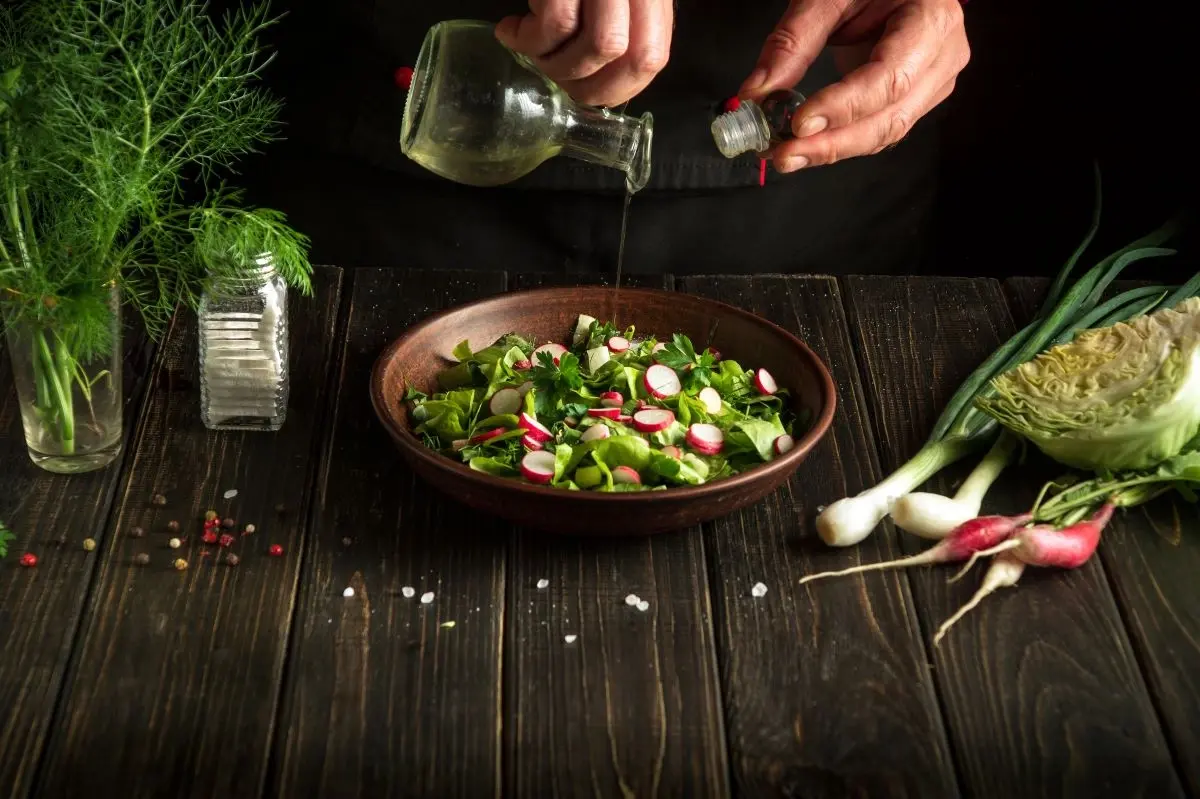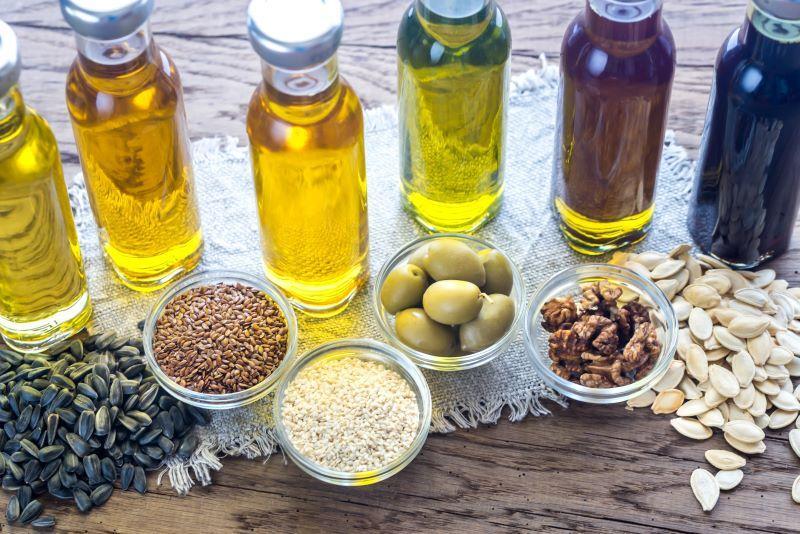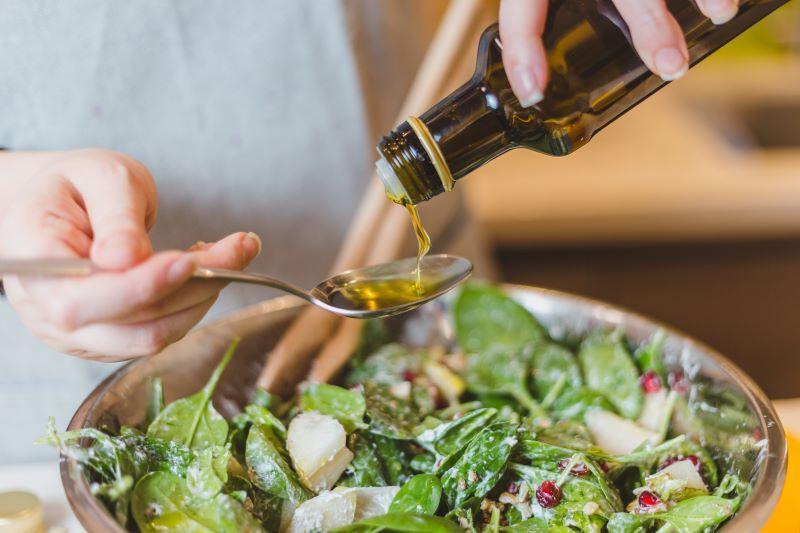Vegetable oils in cooking: technical applications

What vegetable oil can I use in cooking?
Oils have 2 distinct origins: animal or vegetable.
Whatever their origin, they can be used in both food and cosmetics. In this article, we'll focus on vegetable oils and their use in cooking.
Their possibilities are numerous in gastronomy, nutrition and cosmetics. Each oil will be used in a particular field according to its molecular or olfactory profile.
Certain edible vegetable oils can be used in cooking for their flavor, but some can also be used for external cosmetic purposes. In Morocco, for example, argan oil is traditionally used in cooking as well as for cosmetic purposes; in India, sesame oil and in the rest of Asia, coconut oil.
All vegetable oils are derived from seeds of varying sizes (e.g. black cumin, hemp), nuts or oleaginous fruits (e.g. almond, jojoba, hazelnut, coconut) or fruit stones (apricot, plum).
Last but not least, these vegetable oils also have nutritional benefits.
To help you find your way among the many vegetable oils, their possible uses and their benefits, here's a short guide.
It will help you choose edible vegetable oils according to your wishes (neutral or pronounced flavor, mild or strong) and your culinary needs (seasoning, frying, cooking).

Vegetable oil classification and characteristics
If you're looking for a vegetable oil for culinary use, you may be a little confused by the vast choice. It's essential to know the characteristics of each one to use them properly and to know what they can give you in terms of nutrition too. In the following lines, we'd like to tell you a little more about the differentvegetable oils that can be used in cooking.
Oils can be classified according to various aspects:
- their molecular weight, which has an impact on their use and nutritional profile,
- their smoke point, which influences their use in cooking,
- their nutritional profile.
Vegetable oils are made up of fatty acids. These fatty acids can be classified according to the size of their molecule (or molecular weight), and the structure of their carbon chain, which can be single or double-bonded. If this sounds complicated, remember that this is why some fatty acids are called "saturated" and others "unsaturated". The latter are those with a double bond.
Unsaturated fatty acids are further subdivided into polyunsaturated and monounsaturated fatty acids.
Unsaturated fatty acids include :
- Monounsaturated fatty acids, whose main representative is omega 9, found in olive oil.
- Polyunsaturated fatty acids, also known as "essential" fatty acids, subdivided into omega 3 and omega 6. The ratio recommended by health authorities is to consume 5 times more omega 6 than omega 3.
This fatty acid composition impacts their nutritional profile, their use in cooking and their state (solid or cold liquid).
Coconut oil is mainly made up of saturated fatty acids: it is therefore solid when cold and becomes liquid at room temperature.
The length of their carbon chain defines the oil's smoke point. Above this temperature, oil and fats smoke and begin to decompose. They should not be consumed.
The oil extraction and refining process influences their use.
Here are a few examples
- unrefined oil extracted by the first cold-pressing process cannot be cooked.
- some refined oils can withstand high temperatures, such as grapeseed oil, peanut oil and olive oil, which can withstand cooking at 200°C.
It's easy to see why some vegetable oils are recommended for cold use (in vinaigrettes, for example, or drizzled over mashed potatoes), or for gentle cooking, while others are ideal for frying.
Different oils for different cooking purposes
Oils traditionally recommended for frying (240°C maximum):
- Refined grapeseed oil,
- Peanut oil,
- Landema organic coconut oil.
Oils for cooking up to 180°C:
- Refined olive oil,
- Refined rapeseed oil
- Landema organic plum oil
Oils for the end of cooking or drizzled over a hot dish before serving:
- Avocado kernel oil,
- Landema organic camelina oil
Oils for cold cooking:
- First-press oils extracted cold and rich in omega 3:
- walnut oil,
- rapeseed oil
- linseed oil,
- hemp oil,
- camelina oil.
- Some landema oils are best known for their cosmetic uses :
- sweet almond oil,
- argan oil,
- hazelnut oil,
- jojoba oil,
- apricot kernel oil,
- black cumin oil.
Finally, vegetable oils are also interesting for their nutritional profiles.
The composition of edible vegetable oils:
Vegetable oils are composed in varying proportions of :
- fatty acids: saturated and unsaturated.
- Saturated fatty acids, in excess, are harmful to health, according to nutritionists. In the case of edible vegetable oils, they are found mainly in coconut and palm oil.
- Unsaturated fatty acids
- Monounsaturated or omega-9 fatty acids. With 60-70% omega 9 in its composition, olive oil is the vegetable oil with the highest content, along with sunflower oil, which can contain up to 80%. Landema plum oil also contains some.
- Polyunsaturated GAs are also known as omega 3 and omega 6. Like the former, they are also renowned for their health benefits. Rapeseed oil contains a high proportion of omega-3s, which are also found in unrefined walnut, linseed and Landema camelina oils. Rapeseed oil contains two to three times more omega-6 than omega-3, the most interesting ratio for our consumption.
- Monounsaturated or omega-9 fatty acids. With 60-70% omega 9 in its composition, olive oil is the vegetable oil with the highest content, along with sunflower oil, which can contain up to 80%. Landema plum oil also contains some.
- vitamins A and E
Finally, first-pressed, cold-extracted edible vegetable oils with interesting nutritional profiles can also be used externally on the face or body.
This list includes Landema sweet almond, organic deodorized argan, organic hemp, organic coconut, organic jojoba, organic hazelnut, organic black cumin and organic kernel oils.

What you need to know about vegetable oils :
General
- it's important to mix and vary oils to benefit from their nutritional profile
- non-refined oils extracted by first cold-pressing have health benefits
- omega-3-rich oils have a short shelf life and should be stored in the fridge
- packaging should be opaque to protect from light
- the recommended daily intake is 3 tablespoons of vegetable oil (for an adult).
Some oils and their uses:
- Rapeseed oil can be used to season salads and for gentle cooking (except refined rapeseed oil).
- The fragrant taste of walnut oil will enhance your salads. Its ratio of omega-6 to omega-3 is slightly lower than that of rapeseed oil.
- Coconut oil is low in unsaturated fatty acids, but is highly resistant to high temperatures (200°C). This is why it is recommended for cooking and frying. Its slightly exotic taste makes it ideal for concocting delicious recipes.
- Landema organic plum oil with its delicate bitter almond taste will add a subtle aroma to your cakes or pancakes.

In the course of these lines, you've learned about a number of factors that will help you decidewhich vegetable oil to use in your cooking. When making your choice, always opt for organic, first cold-pressed oils. For this, you can rely on the ones we offer at Landema, because the quality of our products is always at the heart of our concerns!
Share this article (attention it seems to be written "patager")
You must be logged in to post a comment.



